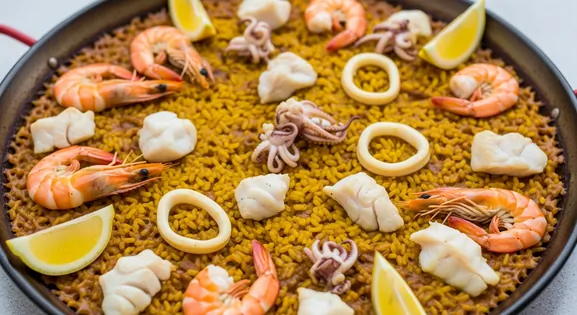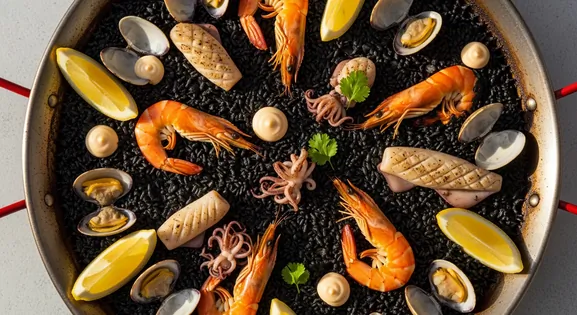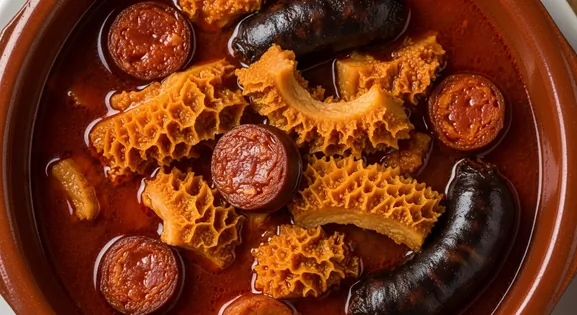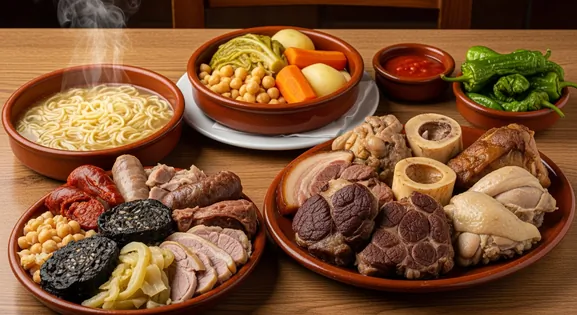Aceitunas Aliñadas in Spain: A Complete Food Lover's Guide
Aceitunas Aliñadas
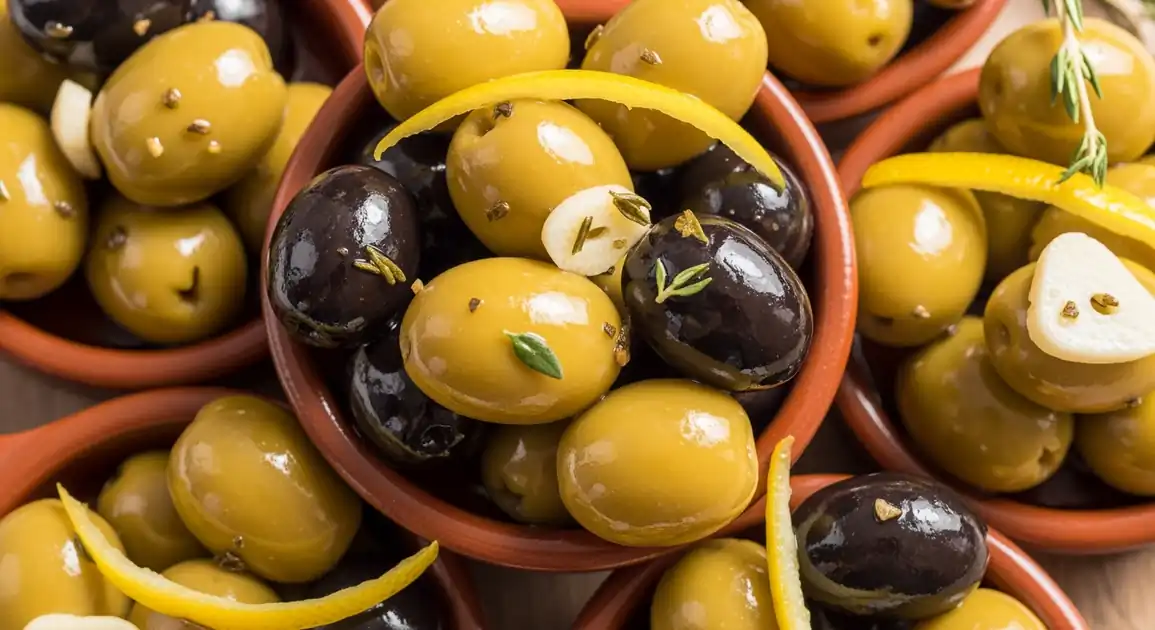
The Basics of Aceitunas Aliñadas (Marinated Olives)
Aceitunas Aliñadas (Marinated Olives) are a cornerstone of Spanish tapas culture and cuisine. These olives, ranging from the crisp green Manzanilla to the fleshy giant Gordal, are cured and then infused ('aliñadas') with flavorful marinades typically based on olive oil, garlic, herbs, and spices. Served in countless variations across Spain, they are the quintessential savory 'aperitivo'.
A Traveler's Guide to Authenticity
What to Look For
-
Plump, vibrant appearance
Indicates freshness and good quality olives. Color should be appropriate for the type.
-
Clear, clean marinade
The olive oil or brine should not look cloudy, dirty, or have scum on top.
-
Fresh, pleasant aroma
Should smell invitingly of olives, garlic, and herbs. Avoid sour, rancid, or fermented smells.
-
Reputable source
Busy bars, specialized market stalls, or trusted brands indicate better quality control and freshness.
-
Clean serving dish/container
Basic hygiene indicator for how the olives are stored and served.
What to avoid
-
Mushy or excessively soft texture
Can indicate spoilage or poor quality olives.
-
Dull color or visible mold/spots
Clear signs of spoilage; do not eat.
-
Cloudy, foamy, or dirty-looking brine/oil
Suggests contamination or that the olives have been sitting for too long improperly stored.
-
Rancid oil smell or sour/fermented odor
Indicates spoilage. Trust your senses.
-
Uncovered olives exposed to flies/dust
Especially relevant at markets or outdoor stalls. Choose covered or protected olives.
How to Order Aceitunas Aliñadas (Marinated Olives)
Perfect Partners: What to Pair
Fino or Manzanilla Sherry
Wine
The crisp, dry, and slightly saline notes of Fino or Manzanilla sherry perfectly complement the briny, savory flavors of marinated olives, enhancing the overall Spanish tapas experience.
Light Lager or Pale Ale
Beer
A refreshing, crisp lager or pale ale provides a clean palate cleanser that balances the richness of the olive oil and the intensity of the garlic and herbs.
Explore Aceitunas Aliñadas (Marinated Olives) in Detail: City Guides
Discover where to find the best Aceitunas Aliñadas (Marinated Olives) and learn local tips in these cities:
History and Origins
Olive cultivation has shaped the Spanish landscape and cuisine for millennia, dating back to Phoenician and Roman times. The practice of curing and marinating olives is equally ancient, developed as a preservation method and a way to enhance flavor. Regional 'aliños' (marinades) evolved based on local ingredients and traditions. The integration of olives into the tapas ritual solidified their place as an indispensable element of Spanish social eating and hospitality.
Deconstructing Aceitunas Aliñadas (Marinated Olives): Ingredients and Method
Olives must first be cured (typically in brine) to remove bitterness (oleuropein). After curing, they are 'aliñado' (marinated). This involves rinsing the olives and immersing them in a mixture that usually includes extra virgin olive oil, crushed or sliced garlic, dried herbs (like oregano, thyme, rosemary), spices (like paprika or cumin), citrus peel (lemon or orange), and sometimes vinegar or chili. Olives might be cracked ('machacadas') or slit ('partidas') to help them absorb the marinade more deeply. They are left to macerate for hours or days to develop flavor.
Key Ingredients of Aceitunas Aliñadas (Marinated Olives)
Spanish Olives
The foundation of the dish, typically green varieties like Manzanilla, Gordal, or Hojiblanca, known for their firm texture and briny flavor. Black olives are also used.
Quality indicator: Look for plump, unblemished olives with a vibrant color appropriate for their type.
Extra Virgin Olive Oil
A high-quality olive oil is crucial, as it forms the base of the marinade, infusing the olives with its fruity, sometimes peppery, notes.
Quality indicator: The oil should be clear, golden-green, and have a fresh, aromatic scent.
Garlic
Fresh garlic, often crushed or thinly sliced, provides a pungent and aromatic counterpoint to the olives' brininess.
Quality indicator: Look for firm, unsprouted garlic cloves with a strong, fresh aroma.
Local Aceitunas Aliñadas (Marinated Olives) Variations in Spain
Aliño Clásico / Tradicional
A common baseline marinade featuring garlic, oregano, thyme, paprika, olive oil, and sometimes a touch of vinegar.
Aceitunas Picantes
Marinated with whole chili peppers ('guindillas'), chili flakes, or spicy paprika for heat.
Aceitunas Machacadas / Partidas
Olives that have been cracked or split open before marinating, allowing them to absorb more flavor. Very traditional style.
Manzanilla Aliñada
Small, crisp green Manzanilla olives marinated, often simply with garlic and herbs.
Olives with Citrus Peel
Marinades incorporating strips of lemon or orange peel for a fresh, aromatic note.
Campo Real Olives
A specific type of olive from Madrid region, often greenish-brown, known for being seasoned with herbs and having a unique flavor.
Olives with Citrus Peel
Marinades incorporating strips of lemon or orange peel for a fresh, aromatic note.
Dietary Information
Dietary Information
Important Note for Travelers: Your safety is our priority. Below are the common allergens associated with the traditional preparation of this dish. However, recipes and ingredients can vary significantly between establishments. Always confirm all ingredients directly with the food vendor before ordering, especially if you have a severe allergy.
Potential Allergens
Dietary Suitability
Frequently Asked Questions about Aceitunas Aliñadas (Marinated Olives)
What are Aceitunas Aliñadas?
Aceitunas Aliñadas are marinated olives, a staple Spanish tapa. After curing, olives (like green Manzanilla, large Gordal, or black varieties) are steeped in a flavorful mixture ('aliño') typically containing olive oil, garlic, herbs (like oregano, thyme), paprika, citrus peel, sometimes vinegar or chili. The specific marinade varies greatly by region and vendor.
How do Aceitunas Aliñadas taste?
They offer a complex flavor profile: savory and briny from the olive itself, aromatic from herbs, often pungent with garlic, sometimes tangy from vinegar or citrus, and occasionally spicy ('picante') from chili. The texture depends on the olive type, ranging from firm and crisp to fleshy and tender.
Are Aceitunas Aliñadas safe to eat?
Yes, generally they are very safe. Olives are preserved through curing and marinating. Smart eating involves choosing olives that look fresh (plump, good color), are stored properly (clean container, clear brine/oil), and are from reputable vendors like busy bars or clean market stalls. Avoid any that smell off or look mushy.
What are common ingredients in the marinade ('aliño')?
Core ingredients usually include extra virgin olive oil and garlic. Common additions are herbs (oregano, thyme, rosemary), spices (paprika, cumin, black pepper), chili peppers ('guindillas') or flakes, lemon or orange peel/juice, and sometimes wine vinegar. Variations are endless.
Are Aceitunas Aliñadas vegetarian/vegan/gluten-free?
Yes, typically Aceitunas Aliñadas are suitable for all these diets. The base ingredients (olives, oil, herbs, garlic, vinegar, spices) are plant-based and naturally gluten-free. Always double-check if concerned about cross-contamination or unusual additives, but standard preparations are fine.
What's the difference between green and black olives?
The main difference is ripeness at harvest. Green olives are picked unripe, while black olives are picked when fully ripe. This affects their flavor and texture; green olives tend to be firmer and sharper, while black olives are softer and often milder, though curing methods also significantly impact the final taste.
Expert How-To Guides about Aceitunas Aliñadas (Marinated Olives)
How to Choose Good Aceitunas Aliñadas
Select the best marinated olives by looking for signs of quality and freshness.
- Assess appearance: Olives should look plump and have a healthy color appropriate for their type (bright green, deep purple/black). Avoid dull, bruised, or overly shriveled ones.
- Check the marinade: The oil or brine should look relatively clear and clean, not cloudy, murky, or foamy. Herbs and garlic should look fresh.
- Smell the olives: They should have a fresh, appetizing aroma of olives, herbs, and garlic. Avoid any sour, fermented, or rancid oil smells.
- Observe texture (if possible): Avoid olives that look excessively soft or mushy.
- Consider the source: Prefer busy tapas bars (high turnover), reputable market stalls specializing in olives, or trusted brands if buying packaged.
- Avoid uncovered olives swarmed by flies: Basic hygiene check, especially at outdoor markets.
Eating Olives Like a Spaniard
Enjoy this quintessential Spanish tapa by understanding local customs and etiquette for a truly authentic experience.
- Expect them as an appetizer/tapa: Olives are typically served before a meal or as one of several small dishes (tapas) accompanying drinks.
- Use fingers or provided utensils: In casual bars, eating with fingers is common. Often, toothpicks ('palillos') or small forks are provided.
- Discard pits discreetly: A small bowl or dish is usually provided for olive pits ('huesos'). Place them there neatly.
- Savor the flavor: Appreciate the specific type of olive and the nuances of its marinade ('aliño').
- Pair with drinks: Olives pair classically with beer ('cerveza'), wine ('vino'), vermouth ('vermú'), or sherry ('fino', 'manzanilla').
- Don't fill up: They are meant to stimulate the appetite or be part of a larger tapas spread, not a full meal on their own.
Our Commitment to Quality
At Tasteplorers, our mission is to provide the most accurate and useful travel information in the world. To achieve this, all content on this site is created through our unique editorial framework. We utilize leading AI research tools, guided by our proprietary prompts, and a multi-stage validation process. This entire system is overseen by our editorial team to ensure everything we publish meets our high standards for accuracy, cultural nuance, and practical value for travelers.
Learn more about our Editorial Process and our Mission.
Countries
Explore regions
Europe
Discover Europe's diverse culinary landscape, from Mediterranean flavors to hearty Alpine fare. Learn to navigate markets, decode menus, and eat like a local.
Latin America & Caribbean
Discover the vibrant cuisines of Latin America & the Caribbean. Our expert guide covers everything from Mexican street food to Peruvian ceviche and market tips.
Oceania
Explore Oceania's diverse food scene. Learn about Polynesian earth ovens, Fijian feasts, and the vibrant café culture of Australia and New Zealand.
Southeast Asia
Explore Southeast Asia's diverse food cultures from Thailand to Vietnam. Get expert tips on navigating spice levels, choosing quality vendors, and understanding the rich traditions of the region.


